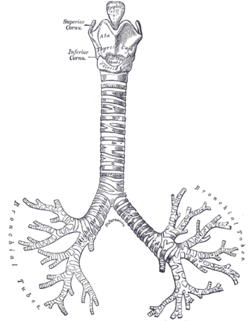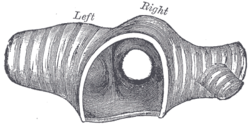Carina of trachea
| Carina of trachea | |
|---|---|
 | |
 Transverse section of the trachea, just above its bifurcation, with a bird’s-eye view of the interior. (Carina not labeled; the ridge that separates the left and right bronchus.) | |
| Details | |
| System | Respiratory system |
| Identifiers | |
| Latin | Carina tracheae, bifurcatio tracheae |
| TA98 | A06.3.01.009 |
| TA2 | 3225 |
| FMA | 7465 |
| Anatomical terminology | |
In anatomy, the carina is a ridge of cartilage in the trachea that occurs between the division of the two main bronchi. This occurs at the lower end of the trachea (usually at the level of the 4th thoracic vertebra, which is in line with the sternal angle, but may raise or descend up to two vertebrae higher or lower with breathing). This ridge lies to the left of the midline, and runs antero-posteriorly (front to back). Foreign bodies that fall down the trachea are more likely to enter the right bronchus.
The mucous membrane of the carina is the most sensitive area of the trachea and larynx for triggering a cough reflex. Widening and distortion of the carina is a serious sign because it usually indicates carcinoma of the lymph nodes around the region where the trachea divides.
Tracheobronchial injury, an injury to the airways, occurs within 2.5 cm of the carina 60% of the time.[1]
Additional images
-
Anatomical dissection of trachea and main bronchi showing the carina
-
Anatomy of the trachea
References
External links
- Atlas image: lung_carina at the University of Michigan Health System - "Cast of trachea and bronchi, anterior view" (#2) [dead link]
- "Trachea and carina — tomogram, coronal plane" at SUNY Downstate Medical Center
- Carina tracheae entry in the public domain NCI Dictionary of Cancer Terms
![]() This article incorporates public domain material from Dictionary of Cancer Terms. U.S. National Cancer Institute.
This article incorporates public domain material from Dictionary of Cancer Terms. U.S. National Cancer Institute.


